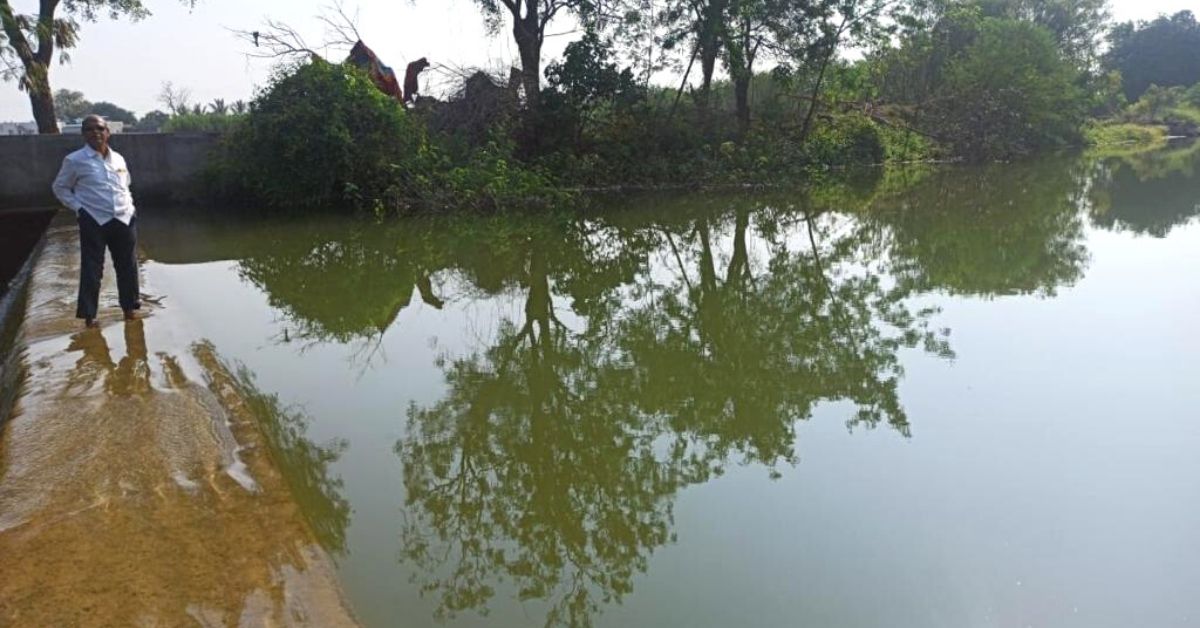In 2014, villagers of Hingangaon, located about 15 km from Ahmednagar in Maharashtra, collected funds to renovate the village school. The student alumni, native professionals working outside the village, and the locals contributed a sum of Rs 70 lakh for the cause.
Happy with the amount that contributors and crowdfunding successfully generated, the villagers wondered that if funds could be collected for school works, could the same be done to conserve water in the drought-hit region?
In 2020, the village, which has a population of 3,500, not only succeeded in making the area drought-free but also reduced migration of locals to other areas.

“The village has been suffering from a water crisis for at least 40 years. Hingangaon falls in the rain shadow region, and hence, experiences less rainfall. During good rain, we saw water running-off the river banks within an hour. It pained us,” says Abasaheb Sonawane, sarpanch of the village.
The 61-year-old village head says residents made multiple attempts to mitigate the water crisis using pipelines and other measures suggested by experts over the years. “All of them failed. Around 2010, two barrages were constructed with the help of the Zilla Parishad. The water storage increased, which in turn helped increase irrigated land for cultivation. But these water conservation efforts did not help the wider population,” he recalls.
The sarpanch says the lack of initiative and shortage of funds reeled in the crisis. “In recent years, the village entirely depended on three water tankers per day to survive even the peak summers. Only one in four attempts in accessing groundwater from the borewell proved successful,” he adds.
Collective efforts
Abasaheb called upon the villagers, student alumni network, professionals and some doctors from the village to contribute funds. From 2014 to 2019, he managed to raise Rs 1 crore and get assistance from state government schemes under the water conservation department, like Jalyukta Shivar.
Old barrages were repaired, and their height was raised to increase water storage. Additionally, 11 other small dams were constructed across an 11-km stretch on the Umbar Nala and Jamgaon Nala, tributaries of river Sina. Some residents contributed machinery for desilting the water bed and increasing the water carrying capacity of the tributaries. Villagers also came forward and offered to pay for the fuel costs of operating the machines. The fertile silt removed from the water bed was used for agriculture to improve yield.
Chandrakant Mulay, sub-divisional water conservation officer at the soil and water conservation department, says, “The villagers saved about 140 crore litres of water. About 70 crore litres of water was stored at the surface, and an equal amount, or more, percolated as groundwater, because the strata of village soil is good.”
Village economy boosted
Abasaheb says that the years of effort finally bore success in 2020. “The village recorded 300 acres of sugarcane cultivation. This is the first time in 40 years that cultivation became possible, due to abundant water availability,” he says.
Mukund Dubey (32), a member of the gram panchayat, says that despite irrigating land for two seasons, the water in the barrages is adequate to survive comfortably in the coming summer. “The existing barrages are filled almost to the brim. The water levels will lower by half during the next couple of months. We are confident that the water needs of the village will be met with the existing water storage,” he adds.
Mukund says that before, he always saw water at the bottom of the wells. “But now the water can be accessed by hand, without a rope,” he adds.
Along with agriculture, the villagers have taken to cattle farming and experimenting with growing corn, onion, wheat and vegetables. “Water has proved to be a crucial element in the escalation of the village economy,” he says.
The gram panchayat member says that the outcome also shows how community participation brings positive change and benefits the entire village.
If you found our stories insightful, informative, or even just enjoyable, we invite you to consider making a voluntary payment to support the work we do at The Better India. Your contribution helps us continue producing quality content that educates, inspires, and drives positive change.
Choose one of the payment options below for your contribution-
By paying for the stories you value, you directly contribute to sustaining our efforts focused on making a difference in the world. Together, let's ensure that impactful stories continue to be told and shared, enriching lives and communities alike.
Thank you for your support. Here are some frequently asked questions you might find helpful to know why you are contributing?

